 |
 |
 |
| |
CONTINUED INEQUITIES IN THE HEPATITIS C CASCADE
OF CARE EXPERIENCED BY PEOPLE WHO INJECT DRUGS
IN BRITISH COLUMBIA IN 2019: A POPULATION-LEVEL
LINKED DATA STUDY
|
| |
| |
As of 2019, there were 52,641 people living in BC diagnosed anti-HCV positive (Figure 1, Panel A), among whom 35% were PWID. Progression to RNA testing was highest among PWID (Overall; 84%, Non- PWID; 82%, PWID; 89%) and progression to genotype testing for all 3 groups was equivalent (Overall; 91%, Non- PWID; 92%, PWID; 90%). However, the proportion of PWID who started HCV treatment was lower than the proportion of non-PWID (Overall; 68%, Non-PWID; 73%, PWID; 59%).
AASLD 2020 Nov 11-16
Reported by Jules Levin
Sofia Bartlett1,2, Stanley Wong2, Amanda Yu2, Margo Pearce1,2, Mawuena Binka2, Hasina Samji2,3, Dahn Jeong2, Hector Velasquez2, Prince Adu1,2, Maryam Darvishian4, Maria Alvarez2, Victoria Cook2, Jason Wong1,2, Jane Buxton1,2, Mel Krajden1,2 and Naveed Janjua1,2, (1)University of British Columbia, (2)British Columbia Centre for Disease Control, (3)Faculty of Health Sciences, Simon Fraser University, (4) British Columbia Cancer Agency
Background: To address inequities in hepatitis C virus (HCV) acquisition and care, and to improve the health of people who inject drugs (PWID), monitoring of the HCV care cascade and identification of factors associated with HCV treatment uptake is required . We constructed HCV care cascades overall, then stratified for PWID and non-PWID with HCV infection living in British Columbia (BC) in 2019, and investigated factors associated with HCV treatment uptake among PWID.
Methods: The BC Hepatitis Testers Cohort (BC-HTC) includes all individuals tested for HCV in BC since 1990, linked to data on prescription drugs, medical visits, hospitalizations and mortality. We defined six care cascade stages: 1) anti-HCV diagnosed; 2) RNA tested; 3) RNA positive; 4) genotyped; 5) initiated treatment; and 6) achieved post-treatment sustained virologic response . Factors associated with treatment uptake were assessed among PWID confirmed HCV RNA positive, using multivariable logistic regression
Results: As of 2019, there were 52,641 people living in BC diagnosed anti-HCV positive (Figure 1, Panel A), among whom 35% were PWID. Progression to RNA testing was highest among PWID (Overall; 84%, Non- PWID; 82%, PWID; 89%) and progression to genotype testing for all 3 groups was equivalent (Overall; 91%, Non- PWID; 92%, PWID; 90%). However, the proportion of PWID who started HCV treatment was lower than the proportion of non-PWID (Overall; 68%, Non-PWID; 73%, PWID; 59%). In the adjusted logistic regression model (Figure 1, Panel B), cirrhosis (adjusted odds ratio [aOR] 2.14; 95% Confidence Intervals [CI] 1 .86-2 .46), HIV coinfection (aOR 2 .01; 95%CI 1 .80-2 .26), major mental illness diagnosis (aOR 1.20; 95%CI 1 .13-1 .27), and HBV coinfection (aOR 1 .17; 95%CI 1 .05- 1 .31) were associated with HCV treatment uptake among HCV RNA positive PWID . Factors negatively associated with treatment uptake among HCV RNA positive PWID included active TB coinfection (aOR 0 .59; 95%CI 0 .42-0 .81), alcohol use disorder (aOR 0 .86; 95%CI 0 .81-0 .91), and never having received OAT (vs . recent OAT; aOR 0 .81; 95%CI 0 .76-0 .87).
Conclusion: Despite removal of HCV treatment eligibility restrictions in BC in early 2018, inequities in HCV treatment uptake persist for PWID. Associations between major mental illness, HIV or HBV coinfections, and HCV treatment uptake among PWID may be due to more frequent engagement with social or health services among people with these diagnoses. Negative associations between HCV treatment uptake and active TB infection, never having received OAT, and alcohol use disorder among PWID suggest additional supports may be needed to facilitate HCV treatment uptake among highly marginalized people. Models of HCV care that are low barrier and integrated with primary care and social supports may be successful at addressing inequities in the HCV care cascade experienced by PWID in BC.
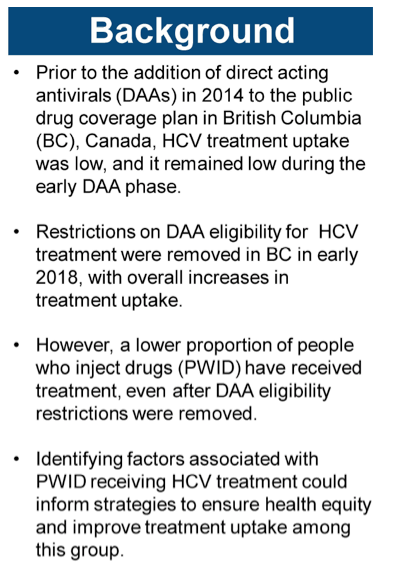
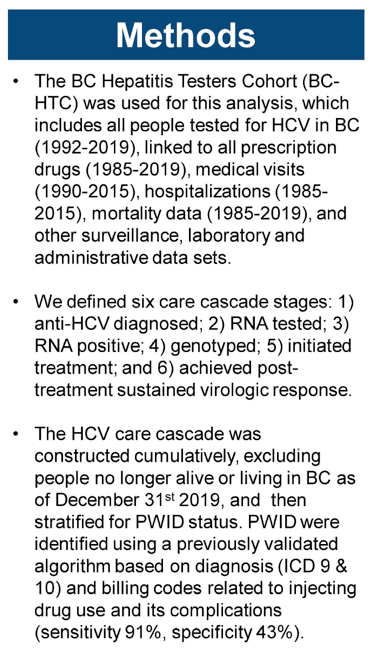
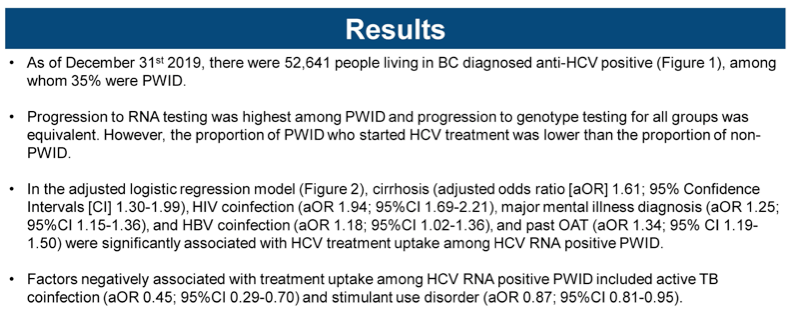

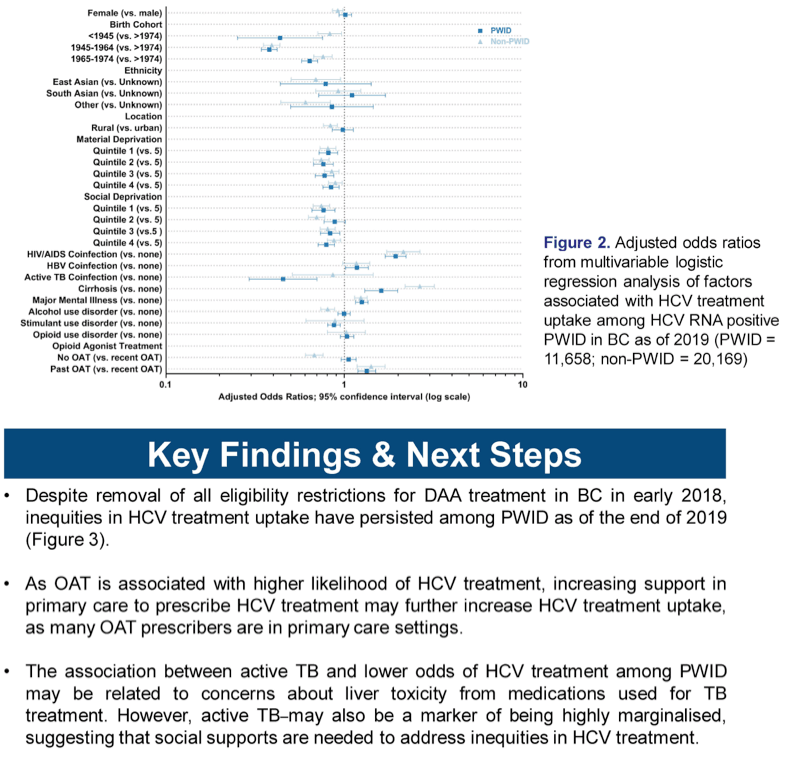
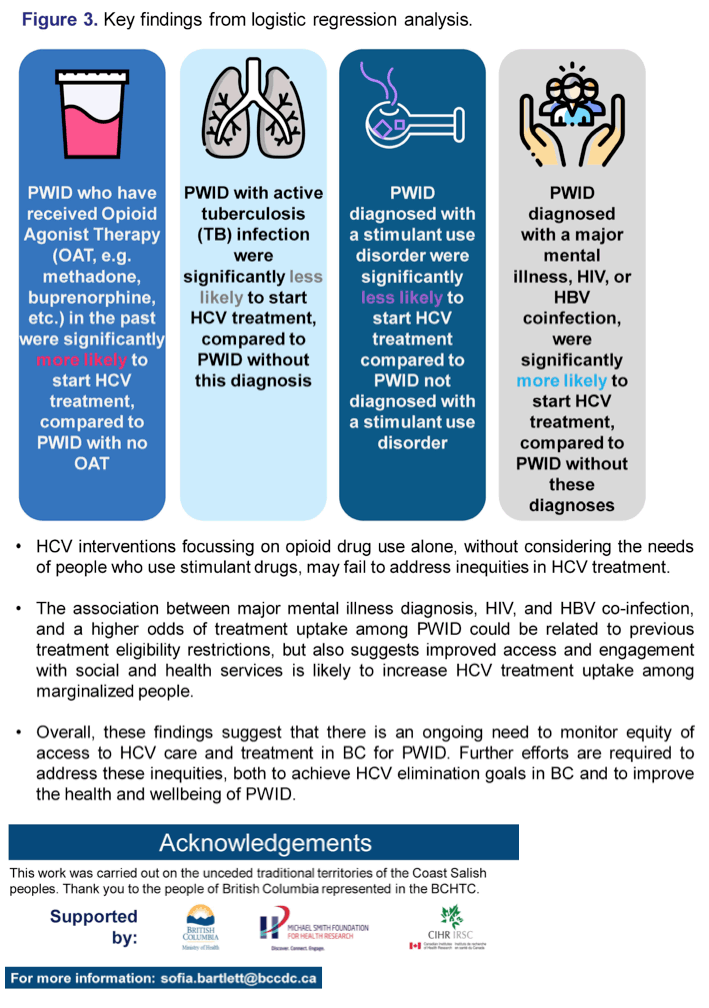
|
| |
|
 |
 |
|
|